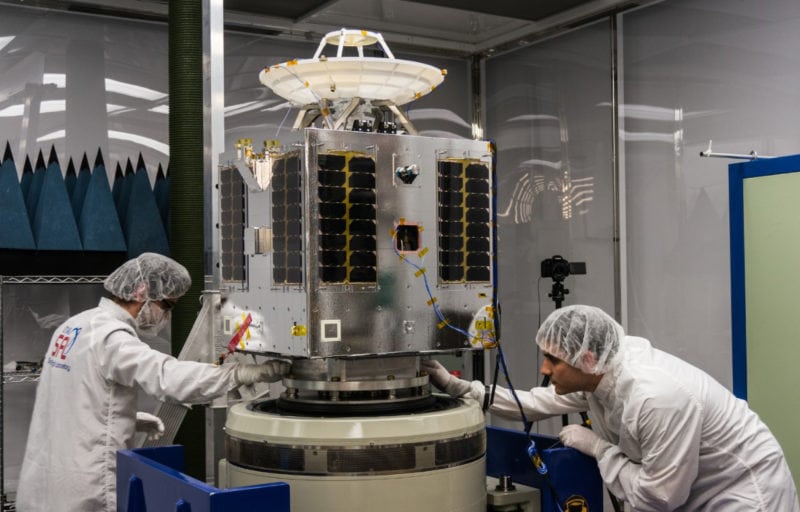Big Primes Squeezing into a Smallsat World

SSL-Built small satellite for Telesat. Photo: SSL
Following Boeing’s acquisition of Millennium Space Systems in August, all of the leading prime contractors in the manufacturing sector have made a play in the small satellite market. Lockheed Martin’s investment in Terran Orbital, Airbus’s joint venture with OneWeb, Thales Alenia Space’s partnership with Spaceflight Industries, and SSL’s in-house development, among others, have each committed resources to smallsat manufacturing capabilities. With all eyes now turning to the smallsat market, what are the main drivers and where will we see the greatest impact from these moves?
Smallsats are capturing significant industry and mainstream media attention, with some positioning smallsats as the future of the industry. The smallsat market certainly presents a growing opportunity, with a Compound Annual Growth Rate (CAGR) of 15 percent and launch forecasts exceeding 4,500 1-500 kilogram satellites through 2025. This far outpaces activity in the greater than 500 kg satellite market, at negative ten percent CAGR and only 650 satellites to launch in the same time period. Yet large satellites will continue to dominate the revenue opportunity, with smallsats generating less than a fifth the manufacturing revenue of their largesat counterparts by 2025.
Despite being a smaller overall revenue opportunity in the near term, in many ways going after incremental smallsat business is a logical step for primes. The market shows strong potential for growth across multiple customer types and applications, and given declines in the previously robust commercial Geostationary Orbit (GEO) satcom business, smallsat business represents an attractive way for primes to bolster their bottom line. Ongoing smallsat activity can also help to smooth out more sporadic larger satellite demand.
The benefits of integrating both small and large capabilities extend beyond capturing new revenue. The potential to leverage the innovation and lessons learned from smallsat design and manufacturing processes towards other product lines could enhance overall capabilities and efficiencies.
As customers increasingly seek satellites across the range of mass and capability classes, in many cases operating hybrid system architectures, it will be advantageous to offer a myriad of solutions to more comprehensively address their requirements. This is particularly true for the government and military customers that have been a mainstay of big primes’ books. More and more, these customers are looking to smallsats to boost persistence, resilience, and responsiveness of space-based services, and primes are well-positioned to leverage existing relationships and understanding of customer practices to win new contracts.
Yet, as the satellite market continues to diversify, it will be increasingly difficult for a prime manufacturer to remain the one-stop-shop for satellite needs. There already exist a multitude of smallsat manufacturers with on-orbit heritage and experience — both in more generalist positions and actively addressing demand in various niche markets. Opportunities certainly remain, but primes can easily underestimate the nuances of the market and complexity of capturing demand or growing the pie. Tailoring offerings to specific segments of the smallsat market will be a key component to offer unique value and compete with incumbents.
The technical and commercial skillsets of prime manufacturers are largely best suited to demand for high reliability requirements and more exquisite capabilities across both bus and payload. This encompasses much emerging government and military demand, but is also a growing component of commercial smallsat demand as companies seek unique data sets and services.
With many smallsat manufacturers continuing to grow organically rather than leverage Venture Capital (VC) or Corporate Venture Capital (CVC) funding, smallsat divisions at large primes will benefit from the easier access to capital to develop product lines, build facilities, or engage in Research and Development (R&D_. While this will present a challenge to today’s smallsat manufacturers and emerging start-ups, the counterpoint is a more bureaucratic environment that could hinder development and responsiveness to market changes.
The key risk for big primes — and the opportunity for incumbent smallsat manufacturers they are soon to compete with — is this adaptability to smallsat dynamics and ability to fully leverage the advantages of smallsat-based systems. The value of smallsats relies in large part on agility, lower cost structures, different risk postures, and rapid iteration and innovation that can be challenging to cultivate in the more structured environments and decision-making hierarchies characteristic of big primes. In the case of acquisition or partnership between a smallsat player and prime, how much of the original company culture and structure that facilitated innovation will remain viable once swallowed into a larger entity? The scope of market impact depends on primes’ ability to adopt this more agile approach.
Finally, more and more deals in the smallsat market are becoming partnership driven, with owner/operators looking to a manufacturer to play a larger role in design trades and system development. End-to-end services are increasing in popularity. This ultimately demands added flexibility and a greater commitment to the satellite owner/operator, and it remains to be seen how committed and successful large primes will be in targeting and winning these customers.
Prime manufacturers are taking steps to ensure they are not left out of the small satellite opportunity, creating unique approaches to squeeze in this growing market. Yet competition from more agile small businesses that have built the industry and are a byproduct of its innovation will consistently challenge primes’ efforts to build market share. It is far from certain to what extent large primes will be able to successfully capitalize on their strategies and capture significant smallsat demand from incumbents. Ultimately, in this growing market there are roles for many players – so long as each identifies a unique way to generate value.

Carolyn Belle is a senior analyst with NSR, focusing on satellite manufacturing, launch, and in-space activity, and in particular the trends surrounding creation of diversified space architectures.